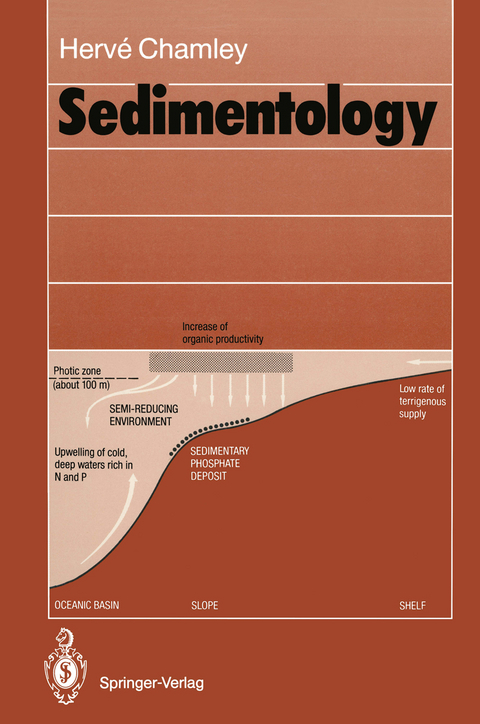
Sedimentology
Springer Berlin (Verlag)
978-3-540-52376-5 (ISBN)
- Titel ist leider vergriffen;
keine Neuauflage - Artikel merken
lt;b>Sedimentology is an easily readable textbook for undergraduate students, devoted to the main factors of sedimentation and to sedimentary environments. The basic vocabulary and the main processes are presented in a very attractive form. The presentation of sedimentary processes is illustrated by many examples. While most cases are related to present day sedimentation, a few applications to past sedimentary environments are also supplied for each considered topic.
1 Origin of Sedimentary Components.- 1.1 Terrigenous Clastic Particles.- 1.1.1 Introduction.- 1.1.2 Physical Weathering.- 1.1.3 Chemical Weathering.- 1.1.4 General Distribution of Mineral Associations Resulting from Weathering.- 1.1.5 Paleogeographic Application.- 1.2 Formation of Sedimentary Carbonates.- 1.2.1 Introduction.- 1.2.2 Main Minerals and Conditions of Formation.- 1.2.3 Primary Chemical Precipitation of Carbonate.- 1.2.4 Organic Contribution to Carbonate Sedimentation.- 1.2.5 Other Factors Contributing to Carbonate Sedimentation.- 1.2.6 General Appearance of Marine Carbonate Sediments.- 1.3 Origin of Other Main Sedimentary Components..- 1.3.1 Silica.- 1.3.2 Phosphates.- 1.3.3 Organic Matter.- 1.3.4 Evaporites.- 2 Properties of Sedimentary Particles.- 2.1 Grain Size.- 2.1.1 Scales.- 2.1.2 Graphic Presentation of Grain Size Data.- 2.1.3 Characterization of Sedimentary Environments.- 2.1.4 Influence of Transport Processes.- 2.2 Shape, Surface, and Orientation of Grains.- 2.2.1 Shape.- 2.2.2 Surface Morphology.- 2.2.3 Spatial Arrangements.- 2.3 Classification of Sediments.- 3 Deposition of Sediments.- 3.1 Principal Transport Mechanisms.- 3.1.1 Sedimentary Particles.- 3.1.2 Flows of Sedimentary Particles.- 3.2 Formation of Basic Sedimentary Structures.- 3.2.1 Introduction.- 3.2.2 Formation of Ripples, Current Structures.- 3.3 Formation of Post-Depositional Sedimentary Structures.- 3.3.1 Erosion Structures.- 3.3.2 Surface Structures or Imprints.- 3.3.3 Synsedimentary Deformation.- 3. 4 General Mechanisms of Sedimentation and Resulting Deposits.- 3.4.1 Settling.- 3.4.2 Gravitational Sliding.- 3.4.3 Deposition by Density or Gravity Currents.- 3.4.4 Deposition by Bottom Currents.- 3.4.5 Deposition by Violent or Exceptional Currents..- 3.5 Identification of Depositional Environments of Ancient Sediments: Potential and Limitations.- 3.5.1 Introduction.- 3.5.2 Distance from Coastline.- 3.5.3 Depth of Deposition.- 3.5.4 Paleocurrents.- 3.5.5 Polarity of Beds.- 4 From Sediment to Sedimentary Rock.- 4.1 Introduction.- 4.2 Formation of Sandstones.- 4.2.1 Main Stages and Classification.- 4.2.2 Surface Phenomena.- 4.2.3 Phenomena of Deeper Levels.- 4.3 Evolution of Clays.- 4.3.1 Early Diagenesis.- 4.3.2 Late Diagenesis.- 4.4 Carbonate Diagenesis.- 4.4.1 Introduction.- 4.4.2 Calcitic Cement.- 4.4.3 Conditions for Dolomitization.- 4.5 Evolution of Siliceous Deposits.- 4.6 Formation of Fossil Fuels.- 4.6.1 Coal.- 4.6.2 Hydrocarbons.- 5 Continental Sedimentation.- 5.1 Glacial Environments.- 5.1.1 Introduction.- 5.1.2 Main Types of Glacial Deposits.- 5.1.3 Glacial Sequences and Environments of the Past.- 5.2 Deserts.- 5.2.1 Introduction.- 5.2.2 Recent Desert Sediments.- 5.2.3 Ancient Desert Sediments.- 5.3 Lakes.- 5.3.1 Introduction.- 5.3.2 Recent Lacustrine Deposits.- 5.3.3 Ancient Lacustrine Deposits.- 5. 4 Alluvial Fans.- 5.4.1 Introduction.- 5.4.2 Alluvial Fans in Humid Regions.- 5.4.3 Alluvial Fans in Arid Regions.- 5.5 Rivers and Streams.- 5.5.1 Introduction.- 5.5.2 Sedimentary Sequences in Recent Fluvial Deposits.- 5.5.3 Ancient Fluvial Environments.- 6 Marine Coastal Environments.- 6.1 Deltas and Estuaries.- 6.1.1 Hydrodynamic and Sedimentational Mechanisms.- 6.1.2 Formation of Delta Complexes.- 6.1.3 Fossil Estuaries and Deltas.- 6.2 Littoral Environments.- 6.2.1 Hydrosedimentary Mechanisms.- 6.2.2 Detrital Environments.- 6.2.3 Carbonate and Evaporite Environments.- 6.3 Shelf Environments.- 6.3.1 General Hydrosedimentary Mechanisms.- 6.3.2 Detrital Environments.- 6.3.3 Carbonate Environments.- 7 Open-Marine Environments.- 7.1 Submarine Relief and Sedimentation.- 7.1.1 Introduction.- 7.1.2 The Continental Margins.- 7.1.3 Abyssal Plains.- 7.2 Dynamics of Deep-Water Sedimentation.- 7.2.1 Continental Margins.- 7.2.2 Open-Marine Basins.- 7.3 Main Deep-Sea Sediments.- 7.3.1 Carbonate Oozes.- 7.3.2 Siliceous Oozes.- 7.3.3 Clays and Argillaceous Oozes.- 7.3.4 Polymetallic or Manganese Nodules.- 7.3.5 Metalliferous and Hydrothermal Sediments.- 7.3.6 Other Sediments.- 7.3.7 Global Tectonics vs Deep-Sea Sedimentation.- 8 References.- 9 Subject Index.
| Erscheint lt. Verlag | 28.9.1990 |
|---|---|
| Übersetzer | Thomas Reimer |
| Zusatzinfo | X, 285 p. 18 illus. |
| Verlagsort | Berlin |
| Sprache | englisch |
| Maße | 155 x 235 mm |
| Gewicht | 522 g |
| Themenwelt | Naturwissenschaften ► Geowissenschaften ► Geografie / Kartografie |
| Naturwissenschaften ► Geowissenschaften ► Geologie | |
| Naturwissenschaften ► Geowissenschaften ► Mineralogie / Paläontologie | |
| Schlagworte | diagenesis • Erosion • fluvial • Geologie • lacustrine • Mineral Resources • Ozeanographie • Paleontologie • Sediment • sedimentary rock • Sedimentation • Sedimentologie • Sediment / Schwebstoffe |
| ISBN-10 | 3-540-52376-6 / 3540523766 |
| ISBN-13 | 978-3-540-52376-5 / 9783540523765 |
| Zustand | Neuware |
| Informationen gemäß Produktsicherheitsverordnung (GPSR) | |
| Haben Sie eine Frage zum Produkt? |
aus dem Bereich


